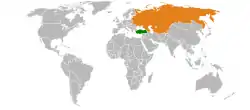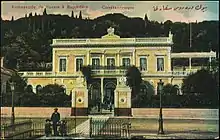 | |
Turkey |
Soviet Union |
|---|---|
| Diplomatic mission | |
| Embassy of Turkey, Moscow | Embassy of the Soviet Union, Ankara |
Soviet Union–Turkey relations were the diplomatic relations between the Soviet Union and the Republic of Turkey.
Background
History
The Soviet Union and the new Turkish governments were outsiders to the great powers and gravitated toward each other after World War I.[1] According to Onur Işçi:
Beginning in 1920, bitterness against the postwar international order drove Soviet-Turkish relations. Nationalist Turks and internationalist Bolsheviks laid to rest four centuries of rivalry between their imperial predecessors as they found themselves in a convergence that each side defined as anti-imperialist. At the heart of their cooperation was a geopolitical alignment that sought to shield the greater Black Sea region from Western intrusions. .... All the way up to the final hours of peace in 1939, the first principle that guided Turkish diplomacy was good neighborly relations with Moscow in the context of friendship rather than subordination.[2]
The Ottoman government signed the Treaty of Brest-Litovsk between the Bolshevik government of Russia and the Central Powers on March 3, 1918, but it became obsolete later that year. Russian Bolsheviks and the Soviet government were led by Vladimir Lenin, who emerged victorious from the Russian Civil War by 1921 and viewed the Turkish revolutionary (national) movement under the leadership of Mustafa Kemal as congenial to their ideological and geopolitical aspirations. Lenin's government abdicated the traditional claims of the Russian Empire to the territories of Western Armenia and the Turkish Straits.
Bolshevik support for Turkish revolutionaries
The Soviet supply of gold and armaments to the Kemalists in 1920 to 1922 was a key factor in the latter's successful takeover of the Ottoman Empire, which had been defeated by the Triple Entente but won the Armenian campaign (1920) and the Greco-Turkish War (1919–1922).[3]
Before the Amasya Circular, Mustafa Kemal met with a Bolshevik delegation headed by Colonel Semyon Budyonny. The Bolsheviks wanted to annex parts of the Caucasus, including the Democratic Republic of Armenia, which were formerly part of Tsarist Russia. They also saw a Turkish Republic as a buffer state or possibly a communist ally. Mustafa Kemal's declined to consider adopting communism until after an independent national was established. Having Bolshevik support was important for the national movement.[4]
The first objective was the securing of arms from abroad. They obtained these primarily from Soviet Russia, Italy and France. These arms—especially the Soviet weapons—allowed the Turks to organise an effective army. The Treaties of Moscow and Kars (1921) arranged the border between Turkey and the Soviet-controlled Transcaucasian republics, while Russia itself was in a state of civil war in the period just before the establishment of the Soviet Union. In particular, Nakhchivan and Batumi were ceded to the future USSR. In return, the nationalists received support and gold. For the promised resources, the nationalists had to wait until the Battle of Sakarya (August–September 1921).
By providing financial and war materiel aid, the Bolsheviks, under Vladimir Lenin aimed to heat up the conflict between the Allies and the Turkish nationalists in order to prevent the participation of more Allied troops in the Russian Civil War.[5] At the same time, the Bolsheviks attempted to export communist ideologies to Anatolia and supported individuals (for example: Mustafa Suphi and Ethem Nejat) who were pro-communism.[5]
According to Soviet documents, Soviet financial and war material support between 1920 and 1922 amounted to: 39,000 rifles, 327 machine guns, 54 cannon, 63 million rifle bullets, 147,000 shells, 2 patrol boats, 200.6 kg of gold ingots and 10.7[6] million Turkish lira (which accounted for a twentieth of the Turkish budget during the war).[6] Additionally the Soviets gave the Turkish nationalists 100,000 gold rubles to help build an orphanage and 20,000 lira to obtain printing house equipment and cinema equipment.[7]
Friendship between the world wars

The Russian Soviet Federative Socialist Republic was the first state that formally recognised the Kemalist government of Turkey in March 1921 after the Republic of Armenia which signed the Treaty of Alexandropol with the Turkish revolutionaries on 2 December 1920. The Treaty of Moscow, signed on 16 March 1921 between Lenin's government and the Grand National Assembly of Turkey government (although the Sultanate was still nominally in existence), followed bilateral treaties that the Moscow government concluded with Persia and Afghanistan earlier that year (apart from those with the states on the territory of the former Russian Empire).
Under the 1921 Treaty of Moscow,[8] the two governments undertook to establish friendly relations between the countries. Under Article II, Turkey ceded Batum and the adjacent area north of the village of Sarp to Soviet Georgia (Kars Oblast went to Turkey). Article III instituted an autonomous Nakhchivan oblast under Soviet Azerbaijan's protectorate. Article V had the parties agree to delegate the final elaboration of the status of the Black Sea and the Turkish Straits to a future conference of delegates of the littoral states if the "full sovereignty" and security of Turkey and "her capital city of Constantinople" were not injured. The Treaty of Moscow was followed by an identical Treaty of Kars signed in October 1921 by the Kemalists with Soviet Armenia, Soviet Azerbaijan and Soviet Georgia, which formed part of the Soviet Union after the December 1922 Treaty on the Creation of the Soviet Union.
On 16 December 1925, the Turkish government withdrew its delegation, which let the League of Nations Council grant a mandate for the disputed region of Mosul to Britain without its consent. Kemal countered the diplomatic reverse[9] by concluding a non-aggression pact[10] with the Soviet Union on 17 December. The pact was later amended and prolonged and then was prolonged again for another ten years on November 7, 1935.[11] The key episode was agreement on the Montreux Convention in July 1936 in which Turkey regained control over the Straits, which it was allowed to remilitarise.[12]
In parallel to the fluctuating bilateral relations, the communist leaders, party functionaries, diplomats and scholars paid close attention to the origins, evolution and transformational phases of Kemalism.[13]
Growing tensions after 1939
Turkey officially remained neutral during the Second World War until 23 February 1945, but the Soviet Union viewed Turkey's continued relationship with Nazi Germany, whose warships were allowed passage through the Straits, as inimical to itself.[14]
On 19 March 1945, Soviet Foreign Minister Vyacheslav Molotov advised Turkey's ambassador in Moscow that the Soviet Union was unilaterally withdrawing from the 1925 Non-Aggression Pact. When the Turkish government enquired on what conditions a new agreement could be concluded, it was informed by Molotov that in addition to bases in the Straits, the Soviets claimed part of eastern Turkey, which was assumed to refer to the districts of Kars, Artvin and Ardahan, which the Russian Empire and the short-lived DRA had held between 1878 and 1921.[15]
Turkey joins NATO
At the Potsdam Conference (July 1945), Stalin demanded a revision of the Montreux Convention. The British and the Americans agreed with the Soviet demand for the Straits always to be open to the warships of the Black Sea powers and, in principle, remain closed to those of outside powers. However, the Soviets also demanded to be allowed to join the defence of the Straits, which was rejected by Turkey, which was backed by the West.[15]
In March 1947, with the proclamation of the Truman Doctrine, the Americans underwrote the frontiers of Turkey and Greece and the continued existence of non-communist governments in both countries.[15]
The Turks sought aid from the Americans and joined NATO in 1952. The Soviets and the Turks were in different camps during the Korean War and throughout the Cold War. In effect the Truman doctrine and NATO contained the Soviets expansion to the South. [16]
See also
References
- ↑ Samuel J. Hirst, “Anti-Westernism on the European Periphery: The Meaning of Soviet-Turkish Convergence in the 1930s.” Slavic Review 72 (2013): 32 – 53.
- ↑ Onur Işçi, "Yardstick of Friendship: Soviet-Turkish Relations and the Montreux Convention of 1936." Kritika: Explorations in Russian and Eurasian History 21.4 (2020): 733-762.
- ↑ В. Шеремет. Босфор. Moscow, 1995, p. 241.
- ↑ Stanford J. Shaw; Ezel Kural Shaw. History of the Ottoman Empire and Modern Turkey. p. 344
- 1 2 Belgelerle Türk tarihi dergisi (Volumes 44-47), Menteş Kitabevi, 2000, p. 87. (in Turkish)
- 1 2 Haydar Çakmak: Türk dış politikası, 1919-2008, Platin, 2008, ISBN 9944137251, page 126. (in Turkish)
- ↑ Embassy of the Russian Federation in Turkey: Rusya Federasyonu'nun Türkiye Cumhuriyeti Büyükelçiliği tarafından yayınlanan 'Yeni Rusya ve Yeni Türkiye: İşbirliğinin İlk Adımları (1920-1930'lu Yıllarda Rus-Türk İlişkileri)' başlıklı broşür hk. Archived 2017-10-12 at the Wayback Machine, accessed on 4 May 2012. (in Turkish)
- ↑ Документы внешней политики СССР. Moscow, 1959, Vol. III, pp. 597-604.
- ↑ John P. Kinross. Atatürk: a biography of Mustafa Kemal, father of modern Turkey. New York, 1965, p. 464.
- ↑ Документы вешней политики СССР. Moscow, 1961, Vol. VIII, pp. 739-741 (text of treaty).
- ↑ Документы вешней политики СССР. Moscow, 1961, Vol. VIII, pp. 813.
- ↑ Mango, Andrew. Turkey. Thames and Hudson, London, 1968, p. 63.
- ↑ Vahram Ter-Matevosyan. "Turkey, Kemalism and the Soviet Union: Problems of Modernization, Ideology and Interpretation" London and New York, Palgrave Macmillan, 2019.
- ↑ Geoffrey Roberts, "Moscow’s Cold War on the Periphery: Soviet Policy in Greece, Iran, and Turkey, 1943—8." Journal of contemporary history 46.1 (2011): 58-81.
- 1 2 3 Mango, Andrew. Turkey. Thames and Hudson, London, 1968, p. 69.
- ↑ George McGhee, The US-Turkish-NATO middle east connection: How the Truman doctrine and Turkey's NATO entry contained the soviets (Springer, 2016).
Further reading
- Gökay, Bülent. Soviet Eastern Policy & Turkey, 1920-1991: Soviet Foreign Policy, Turkey & Communism (2006), 184pp. excerpt
- Hale, William. Turkish foreign policy since 1774 (Routledge, 2012).
- Hashimoto, Chikara, and Egemen B. Bezci. "Do the Kurds have ‘no friends but the mountains’? Turkey's Secret War against Communists, Soviets and the Kurds." Middle Eastern Studies 52.4 (2016): 640-655.
- Hirst, Samuel J. "Transnational Anti-Imperialism and the National Forces Soviet Diplomacy and Turkey, 1920-23." Comparative Studies of South Asia, Africa and the Middle East 33.2 (2013): 214–226. online
- Hirst, Samuel J. “Anti-Westernism on the European Periphery: The Meaning of Soviet-Turkish Convergence in the 1930s.” Slavic Review 72 (2013): 32 – 53.
- Kapur, Harish. Soviet Russia and Asia 1917-1927: A Study of Soviet Policy towards Turkey, Iran and Afghanistan (Geneva Graduate Institute of International Studies, 1966).
- Kiniklioğlu, Suat, and Valeriy Morkva. "An anatomy of Turkish–Russian relations." Southeast European and Black Sea Studies 7.4 (2007): 533–553.
- Kuniholm, Bruce R. //The origins of the Cold War in the Near East: Great power conflict and diplomacy in Iran, Turkey, and Greece (Princeton UP, 2014).
- O’Connor, Timothy Edward. Diplomacy and Revolution: G. V. Chicherin and Soviet Foreign Affairs, 1918 – 1930. (Iowa State UP, 1988).
- Roberts, Geoffrey. "Moscow’s Cold War on the Periphery: Soviet Policy in Greece, Iran, and Turkey, 1943—8." Journal of Contemporary History 46.1 (2011): 58-81.
- Tamkin, Nicholas. Britain, Turkey and the Soviet Union, 1940-45: Strategy, Diplomacy and Intelligence in the Eastern Mediterranean (Springer, 2009).
- Ter-Matevosyan, Vahram. "Turkish transformation and the Soviet Union: navigating through the Soviet historiography on Kemalism." Middle Eastern Studies 53.2 (2017): 281-296. online[
- Ter-Matevosyan, Vahram. "Turkey, Kemalism and the Soviet Union: Problems of Modernization, Ideology and Interpretation" London & New York, Palgrave Macmillan, 2019.
- Zalyaev, Ramil. "The Soviet Attitude Towards Turkey in the First Years of their Relations, and the 1925 Neutrality Treaty." International Journal of Turkish Studies (2005) 11#1-2 pp 107–126. covers 1918 to 1925.
.svg.png.webp)